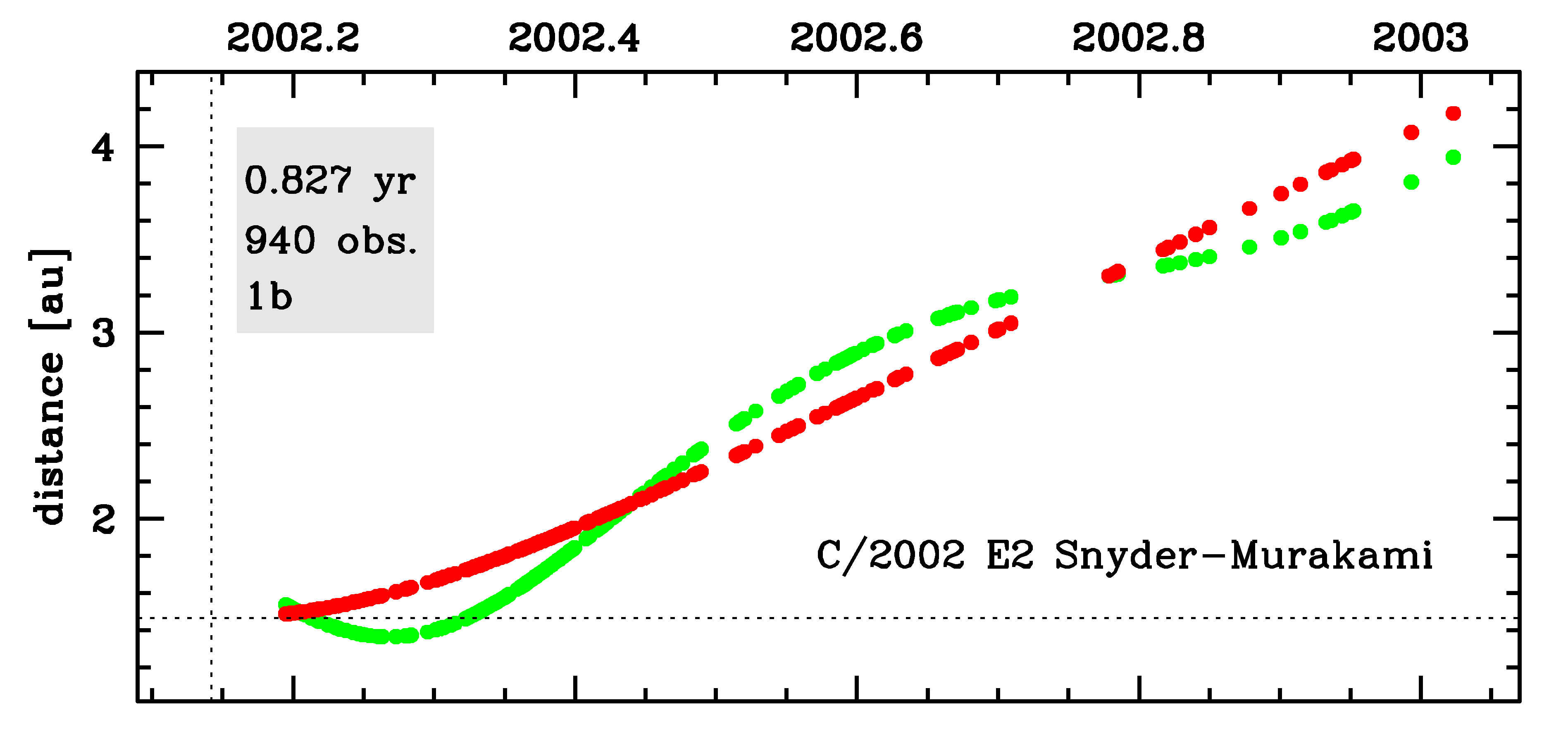C/2002 E2 Snyder-Murakami
more info
Comet C/2002 E2 was discovered on 11 March 2002 by Douglas Snyder (Arizona, US) and Shigeki Murakami (Niigata, Japan), that is about 3 weeks after its perihelion passage. Some earlier images of this comet were next found in Klet Observatory (Czech Republic), Ondřejov Observatory (Czech Republic) and Saku Observatory (Japan), expanding data-arc back in time to 8 March. It was observed until 8 January 2003.
Comet had its closest approach to the Earth on 8 April 2002 (1.367 au), less than a month after discovery.
Solutions given here are based on data spanning over 0.827 yr in a range of heliocentric distances from 1.48 au to 4.18 au.
This Oort spike comet suffers moderate planetary perturbations during its passage through the planetary system; these perturbations lead to escape the comet from the planetary zone on a hyperbolic orbit (see future barycentric orbits).
See also Królikowska 2014.
Comet had its closest approach to the Earth on 8 April 2002 (1.367 au), less than a month after discovery.
Solutions given here are based on data spanning over 0.827 yr in a range of heliocentric distances from 1.48 au to 4.18 au.
This Oort spike comet suffers moderate planetary perturbations during its passage through the planetary system; these perturbations lead to escape the comet from the planetary zone on a hyperbolic orbit (see future barycentric orbits).
See also Królikowska 2014.
| solution description | ||
|---|---|---|
| number of observations | 940 | |
| data interval | 2002 03 08 – 2003 01 08 | |
| data type | observed only after perihelion (POST) | |
| data arc selection | entire data set (STD) | |
| range of heliocentric distances | 1.48 au – 4.18au | |
| detectability of NG effects in the comet's motion | comet with determinable NG~orbit | |
| type of model of motion | GR - gravitational orbit | |
| data weighting | YES | |
| number of residuals | 1863 | |
| RMS [arcseconds] | 0.61 | |
| orbit quality class | 1b | |
| next orbit statistics, both Galactic and stellar perturbations were taken into account | ||
|---|---|---|
| no. of returning VCs in the swarm | 0 | |
| no. of escaping VCs in the swarm | 5001 | |
| no. of hyperbolas among escaping VCs in the swarm | 5001 | * |
| next reciprocal semi-major axis [10-6 au-1] | -428.51 – -425.53 – -422.59 | |
| next perihelion distance [au] | 1.474 – 1.483 – 1.493 | |
| synchronous stop epoch [Myr] | 0.863 | S |
| percentage of VCs with qnext < 10 | 100 | |
| next_g orbit statistics, here only the Galactic tide has been included | ||
|---|---|---|
| no. of returning VCs in the swarm | 0 | |
| no. of escaping VCs in the swarm | 5001 | |
| no. of hyperbolas among escaping VCs in the swarm | 5001 | * |
| next reciprocal semi-major axis [10-6 au-1] | -428.57 – -425.59 – -422.65 | |
| next perihelion distance [au] | 1.637 – 1.649 – 1.662 | |
| synchronous stop epoch [Myr] | 0.89 | S |
| percentage of VCs with qnext < 10 | 100 | |
